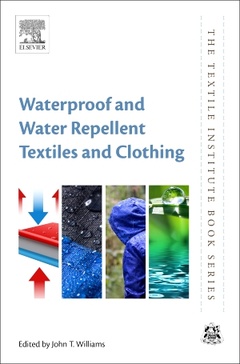Waterproof and Water Repellent Textiles and Clothing The Textile Institute Book Series
Coordonnateur : Williams John T

Waterproof and Water Repellent Textiles and Clothing provides systematic coverage of the key types of finishes and high performance materials, from conventional wax and silicone, through controversial, but widely used fluoropolymers and advanced techniques, such as atmospheric plasma deposition and sol-gel technology. The book is an essential resource for all those engaged in garment development, production and finishing, and for academics engaged in research into apparel technology and textile science. Rapid innovation in this field is driving new performance demands in many areas, including the sporting and military sectors.
However, another innovation driver is the regulatory framework in the USA, Europe and globally, addressing both health concerns (e.g. with PFOS / PFOA) and environmental impacts (e.g. C8 fluorocarbon finishes). Both of these aspects are fully covered, along with the replacement materials / technologies currently available and under development.
In addition, oleophobic and multifunctional coatings are discussed, as are aspects of performance, testing and applications in sportswear, protective clothing, and footwear.
Part I: Principles of waterproofing and water repellency in textiles 1. Introduction to waterproof and water repellent textiles 2. Development of waterproof breathable coatings and laminates 3. Soil repellency and stain resistance (Hydrophobic and oleophobic treatments) 4. Toxicology and environmental issues (PFOA and PFOS) 5. Biomimetic design (pine cones, lotus leaf etc)
Part II: Types of water repellent textile finishes 6. C8 fluoropolymers as water repellent finishes (development of C8 coatings) 7. Other fluorocarbons for repellency (development of C6 coatings) 8. Wax-based water repellents 9. Silicone-based water repellents 10. Hydrophobic dendrimers for water repellency 11. Graphene 12. Plasma-based treatments of textiles for water repellency (low-pressure, atmospheric and dielectric barrier discharge methods) 13. Sol-gel-based treatments of textiles for water repellency 14. Superhydrophobicity 15. Multifunctional water repellent textile finishes (antimicrobial, stain repellence, flame retardance)
Part III: Water repellent textiles in practice: performance, testing and applications 16. Designing waterproof and water repellent clothing for wearer comfort (ventilation, breathability and wicking, thermoregulation) 17. Performance evaluation and testing of water repellent textiles from AATCC, BSI, ISO and ASTM (contact angles, repellency numbers, hydrostatic head, spray test, Bundesmann test (wearer trials of finished garments) 18. Re-proofing of water repellent textiles and clothing (abrasion, laundering, dry cleaning and tumble drying) 19. Sportswear 20. Protective clothing 21. Healthcare textiles 22. Military 23. Footwear
producers of waterproof and water repellent textiles and chemical agents; academics / researchers in textile finishing; undergraduate and graduate students in textile engineering.
- Introduces innovative materials and technologies, exploring their current and potential use across different sectors
- Provides expert guidance on the health and environmental aspects of key waterproof materials and coatings and their associated regulations
- Demystifies testing processes and design principles
Date de parution : 11-2017
Ouvrage de 586 p.
15x22.8 cm
Thèmes de Waterproof and Water Repellent Textiles and Clothing :
Mots-clés :
Absorbent; Aerogel; Alternatives assessment; Application; Barrier; Barrier effects; Bio tolerance; Biomimetic textiles; Breathability; Breathable fabrics; Chemical hazard assessment; Circular economy; Clothing; Clothing design; Coagulation process; Coated fabrics; Coating; Coatings; Co-design; Comfort; Contact angle; Dendrimer; Durable water repellents (DWRs); Fabric; Fabrication; Fabrics; Fibre; Fibres; Finishing; Fluorochemical; Fluorochemicals; Functional requirements; Hazard; Healthcare; Hydrophobic; Hydrophobicity; Laminate; Laminated fabrics; Layering system; Liquid robustness; Lotus effect; Measurement; Medical; Microclimate; MLSE; Multifunctional textiles; Multifunctionality; Nanoparticles; Oil repellency; Oleophobic and hydrophobic treatments; Perfluorinated; Performance evaluation; Perspiration; PFHA; Plasma; Plasma treatments; Polymer; Protective clothing; Reentrant fibres; Repellence; Repellency; Roughness; Silicone; Soft shell; Soil repellency; Sol-gel; Sol-gel treatment; Stain resistance; Superhydrophobic; Superhydrophobic fibres; Superhydrophobic textiles; Superhydrophobicity; Supernonwetting; Superoleophobic; Superomniphobic; Superrepellent textiles; Surface energy; Surface tension; Surface treatments; Sustainable practice; Test methods; Textile; Textile constructions; Textile finishing; Textiles; Theoretical model; Thermophysiological comfort; Toxicology; Water repellency; Water repellent; Water repellent textiles; Water repellents; Water resistant textiles; Waterproof; Waterproof and water repellent clothing; Waterproof breathable fabrics; Wearing comfort; Wettability; Xerogel



